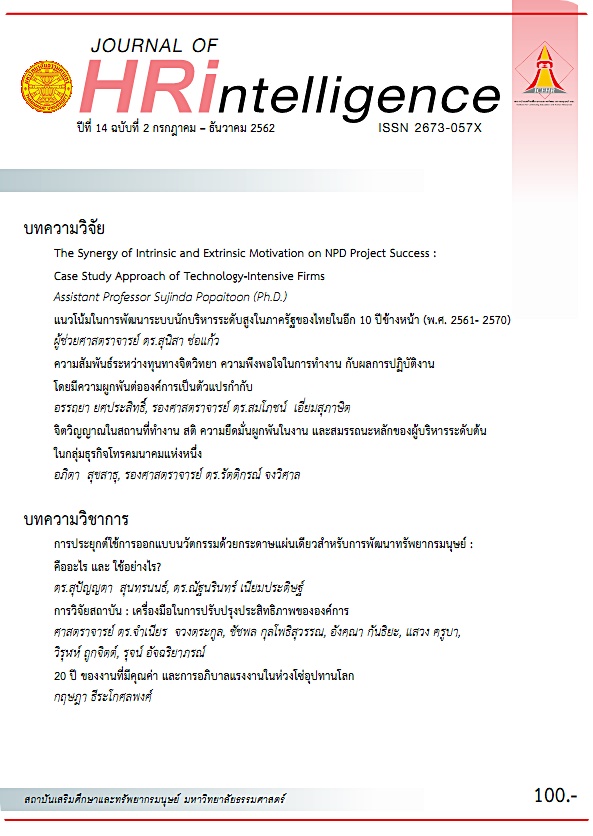ความสัมพันธ์ระหว่างทุนทางจิตวิทยา ความพึงพอใจในการทำงาน กับผลการปฏิบัติงาน โดยมีความผูกพันต่อองค์การเป็นตัวแปรกำกับ
Main Article Content
บทคัดย่อ
การวิจัยครั้งนี้มีวัตถุประสงค์เพื่อศึกษาความสัมพันธ์ระหว่างทุนทางจิตวิทยา ความพึงพอใจในการทำงาน กับผลการปฏิบัติงาน โดยมีความผูกพันต่อองค์การเป็นตัวแปรกำกับ กลุ่มตัวอย่างในการวิจัยครั้งนี้ ได้แก่ พนักงานขายเครื่องดื่มของบริษัทเอกชนแห่งหนึ่งในเขตกรุงเทพมหานคร จำนวน 142 คน เครื่องมือที่ใช้ในการเก็บรวบรวมข้อมูลวิจัย ได้แก่ แบบสอบถามข้อมูลส่วนบุคคล แบบสอบถามทุนทางจิตวิทยามีค่าความเที่ยงเท่ากับ .955 แบบสอบถามความพึงพอใจในการทำงานมีค่าความเที่ยงเท่ากับ .912 แบบสอบถามความผูกพันต่อองค์การมีค่าความเที่ยงเท่ากับ .899 และผลการปฏิบัติงานวิเคราะห์ข้อมูลโดยใช้ค่าสัมประสิทธิ์สหสัมพันธ์ของเพียร์สัน (Pearson product-moment correlation coefficient: PPMCC) และการวิเคราะห์ถดถอยพหุคูณแบบเชิงชั้น (Hierarchical multiple regression analysis) ผลการวิจัย พบว่า ทุนทางจิตวิทยา และความพึงพอใจในการทำงานมีความสัมพันธ์ทางบวกกับผลการปฏิบัติงาน อย่างมีนัยสำคัญทางสถิติที่ระดับ .01 (r = .372, r = .620) ความผูกพันต่อองค์การไม่เป็นตัวแปรกำกับในความสัมพันธ์ระหว่างทุนทางจิตวิทยากับผลการปฏิบัติงาน แต่เป็นตัวแปรกำกับในความสัมพันธ์ระหว่างความพึงพอใจในการทำงานกับผลการปฏิบัติงานอย่างมีนัยสำคัญทางสถิติที่ระดับ .05 (β = .148, ∆R2 = .024)
Article Details
ขอมอบลิขสิทธิ์บทความที่ได้รับการตีพิมพ์ให้แก่สถาบันเสริมศึกษาและทรัพยากรมนุษย์ กรณีมีการฟ้องร้องเรื่องการละเมิดลิขสิทธิ์เกี่ยวกับภาพ กราฟ ข้อความส่วนใดส่วนหนึ่ง และ/หรือข้อคิดเห็นที่ปรากฎในบทความ ให้เป็นความรับผิดชอบของข้าพเจ้าและผู้เขียนร่วมแต่เพียงผู้เดียว
เอกสารอ้างอิง
Allen, N. J., & Meyer, J. P. (1990). The measurement and antecedents of affective, continuance and normative commitment to the organization. Journal of Occupational Psychology, 63, 1-18.
Avey, J. B., Reichard, R. J., Luthans, F., & Mhatre, K. H. (2011). Meta-analysis of the impact of positive psychological capital on employee attitudes, behaviors, and performance. Human Resource Development Quarterly, 22, 127-152.
Bakker, A. B., & Oerlemans, W. (2011). Subjective well-being in organization. In K. S. Cameron & G. M. Spreitzer (Eds.), The Oxford handbook of positive organizational scholarship (pp. 178-189). New York : Oxford University Press.
Baron, R. M., & Kenny, D. A. (1986). The moderator-mediator variable distinction in social psychological research : Conceptual, strategic, and statistical considerations. Journal or Personality and Social Psychology, 51 (6), 1173-1182.
Bovee, C. L. (1993). Management. New York : McGraw-Hill.
Buchanan, B. (1974). Building organizational commitment : The socialization of managers in work organizations. Administrative Science Quarterly, 19, 533-546.
Campbell, J. P., McCloy, R. A., Oppler, S. H., & Sager, C. E. (1993). A theory of performance. In N. Schmitt & W. C. Borman (Eds.), Personnel selection in organizations (pp. 35-70). San Francisco: Jossey-Bass.
Chatabud, B. (2014). The relationship between organizational commitment and organizational citizenship behavior of public organizations employee in Bangkok ; The moderator effect of job satisfaction. Master's thesis, Thammasat University.
Eslami, J., & Gharakhani, D. (2012). Organizational commitment and job satisfaction. Journal of Science and Technology, 2 (2), 85-91.
Feinstein, A. H., & Vondrasek, D. (2001). A study of relationships between job satisfaction and organizational commitment among restaurant employees. Journal of Hospitality, Tourism, and Leisure Science, 1 (4), 1-20.
Gaertner, S. (1999). Structural determinants of job satisfaction and organizational commitment in turnover models. Human Resource Management Review, 9 (4), 479-93.
Guilford, J. P., & Fruchter, B. (1978). Fundamental statistics in psychology and education. Retrieved from http:// www.watpon.in.th/table/pearson.pdf
Hewitt Associates. (2004). Employee engagement higher at double-digit growth companies. Retrieved from http:// www.hewitt.com/doubledigitgrowth
Jacobs, R., & Solomon, T. (1977). Strategies for enhancing the prediction of job performance from job satisfaction. Journal of Applied Psychology, 62 (4), 417-421.
Jernigan, I. E., Beggs, J. M., & Kohut, G. F. (2002). Dimensions of work satisfaction as predictors of commitment type. Journal of Managerial Psychology, 17 (7), 564-579.
Kongchan, A. (1986). Organizational commitment. Chulalongkorn Business Review, 9 (34), 34-41.
Larson, M., & Luthans, F. (2006). Potential added value of psychological capital in predicting work attitudes. Journal of Leadership and Organizational Study, 13 (1), 45-62.
Lok, P., & Crawford, J. (2001). Antecedents of organizational commitment and the mediating role of job satisfaction. Journal of Managerial Psychology, 16 (8), 594-613.
Luthans, F., Youssef, M., & Avolio, B. (2007). Psychological capital : Developing the human competitive edge. Oxford, England : Oxford University Press.
Luthans, F., & Youssef, C. M. (2004). Human, social, and now positive psychological capital management :
Investing in people for competitive advantage. Organizational Dynamics, 33 (2), 143-160.
Luthans, F., Avolio, B. J., Avey, J. B., & Norman, S. M. (2007). Positive psychological capital : Measurement and relationship with performance and satisfaction. Personnel Psychology, 60, 541-572.
Luthans, F., Avolio, B. J., Walumbwa, F. O., & Li, W. (2005). The psychological capital of Chinese workers : Exploring the relationship with performance. Management and Organization Review, 1 (2), 249-271.
Michael, R. (2002). Attitudinal organizational commitment and job performance : A meta-analysis. Journal of Organizational Behavior, 23 (3), 257-266.
Mowday, R., Porter, L., & Steers, R. (1982). Employee-organization linkages : The psychology of commitment absenteeism and turnover. New York : Academic Press.
Mowday, R., Steers, R., & Porter, L. (1979). The measure of organizational commitment. Journal of Vocational Behaviour, 14 (2), 224-247.
Siripanich, R. (1990). Principles of test construction in psychology and education. Bangkok : Charoenwit.
Spector, P. (1985). Measurement of human service staff satisfaction : Development of the job satisfaction survey. American Journal of Community Psychology, 13, 693-713.
Steer, R. M. (1977). Antecedents and outcomes of organizational commitment. Administrative Science Quarterly, 22 (1), 46-56.
Werner, J. M. (1994). Dimensions that make a difference: Examining the impact of in-role and extra-role behaviors on supervisory ratings. Journal of Applied Psychology, 79 (1), 98-107.
Williams, L. J., & Hazer, J. T. (1986). Antecedents and consequences of satisfaction and commitment in turnover models : A re-analysis using latent variable structural equation methods. Journal of Applied Psychology, 71, 219-231.
Withey, M. J., & Cooper, W. H. (1989). Predicting exit, voice, loyalty, and neglect. Administrative Science Quarterly, 34 (4), 521-539.
Youssef, C. M., & Luthans, F. (2007). Positive organizational behavior in the workplace : The impact of hope, optimism, and resilience. Journal of Management, 33 (5), 774-800.


